New Telescope, New Worlds
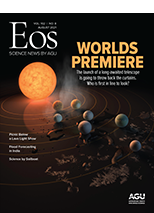
• Exoplanets in the Shadows
• Overture to Exoplanets
• The Forecast for Exoplanets Is Cloudy but Bright
• “Earth Cousins” Are New Targets for Planetary Materials Research
• Oddballs of the Exoplanet Realm
• Thousands of Stars View Earth as a Transiting Exoplanet
• Taking Stock of Cosmic Rays in the Solar System
• Gap in Exoplanet Size Shifts with Age
• Unveiling the Next Exoplanet Act
The long-awaited launch of the James Webb Space Telescope ( JWST) is finally in sight. Astronomers around the world are anticipating the wealth of information the flagship will gather on everything from the oldest galaxies in the universe to the birthplaces of stars and planets.
“It really is a Swiss army knife telescope with a huge range of applications,” said Elisabeth Matthews, an astronomer at Observatoire de Genève in Switzerland.
JWST, built by a team of more than 1,200 people from 14 countries, will collect infrared (IR) light across a broad range of wavelengths. That makes it ideally suited to studying exoplanets, which bury most of their secrets deep in the infrared spectrum. In this way, among many others, JWST will build on the legacies of the Hubble and Spitzer space telescopes, both of which astronomers have used to make revolutionary leaps in our understanding of distant worlds, although neither telescope was designed to do so. JWST’s instruments, on the other hand, were designed with exoplanets in mind.
The observatory is scheduled to launch by the end of this year, and exoplanet scientists have long been planning what they want to look at first. In 2020 they submitted their proposals to the telescope’s science team, and the selections for JWST’s first observing cycle were announced in March. (An observing cycle is 1 year, or 8,760 hours, of observing time.) More than 20% of JWST’s time during its first observing cycle will be dedicated to understanding exoplanets.
The unifying theme across the exoplanet observing programs? “One word: diversity,” said Stefan Pelletier, an astronomy doctoral student at Université de Montréal. “All bases are being covered in terms of science cases as well as instrument and observing configurations.”
The list of principal investigators (PIs) and coinvestigators on the accepted programs is also more diverse across many axes of identity than space telescope programs have been in the past. Compared with a recent round of Hubble proposals, a higher percentage of PIs who are women and also PIs who are graduate students will make the first JWST observations.
It’s a testament to the hard work by the team at the Space Telescope Science Institute, Matthews said, “both in making sure [members of] the exoplanet community are able to understand the telescope and design good science experiments for it and also in ensuring that the proposals for these science experiments have been carefully and equitably judged.”
Andrew Vanderburg, an astronomer at the University of Wisconsin–Madison, added, “It’s awesome that the [dual anonymous] peer review—where the reviewers don’t know who wrote the proposals, and vice versa—makes it possible for young scientists with good ideas to be awarded time on the world’s most powerful observatory from day one.”
Prologue: A Shakedown Cruise
JWST promises to be a game changer for understanding how and what types of planets form and what makes them habitable, but for this first cycle it’s unknown how the telescope’s performance will measure up to expectations. “The reviewers very much wanted a robust ‘shakedown cruise,’” said Peter Gao, an exoplanet scientist at the University of California, Santa Cruz. “Several proposals focused on new and interesting observing methods and science cases that are sure to be the testing grounds for similar, larger, and more elaborate proposals in the next cycles.”
The selected exoplanet observations tend to stay well within the telescope’s expected limitations. “JWST time is very precious, so for the first cycle it is understandable that emphasis was put on programs that are ‘safe’ in that they are almost guaranteed to generate good results,” said Alexis Brandeker, an astronomer at Stockholm University. Some observations might be “risky” in that the scientists aren’t sure what they’ll find, but if they do find something, they’ll get a good look at it.
On the science side, there’s variety both in the types of planets targeted for observations and in the types of observations being made. “These include the measurement of mineral cloud spectral features as a way to probe the composition of exoplanet clouds, exploring asymmetries in the dawn and dusk limbs of exoplanets during transits, eclipse mapping, and getting a sense of which rocky exoplanets host atmospheres,” Gao said.
And on the target side, “there is a nice balance between some of the first exoplanets to be characterized, like HD 189733 b, and weird exoplanets whose observations were difficult to interpret, like 55 Cancri e,” said Lisa Đặng, a physics graduate student at McGill University in Montreal. Instead of making limited observations of a wide range of planets, most of the selected exoplanet programs seek to observe one or a few planets in great detail.
Lights Up on a Familiar Scene
In this first observing cycle, “we are going after a lot of known exoplanets that we have observed in the past, so there aren’t many unexplored targets,” Đặng said. “This makes absolute sense since it will be the first time we are going to use these instruments in space and we don’t really know what challenges we will have to deal with yet.”
“There are some really interesting planets…that we already have tantalizing glimpses of from Hubble and Spitzer data,” said Hannah Wakeford, an astrophysicist at the University of Bristol in the United Kingdom. Wakeford, for example, will be targeting a well-studied, but still mysterious, hot Jupiter, HD 209458 b. “The data we currently have from Hubble tell us there is something in this atmosphere, and my program aims to show that it is clouds made from magnesium silicates (glass),” she said.

Tiffany Kataria, a planetary scientist at NASA Jet Propulsion Laboratory in Pasadena, Calif., is part of one of the five programs studying HD 189733b, a hot Jupiter so normal that it’s called canonical. “This planet was one of the first exoplanets whose atmosphere was observed with the Spitzer and Hubble space telescopes, yet there is still much we don’t know about the properties of its atmosphere,” she said. Kataria will make a 3D map of the planet’s glowing dayside to study its wind and temperature patterns, “which tells us a great deal about the physical processes taking place in the atmosphere.”
Néstor Espinoza’s target is hot Jupiter WASP-63 b and, more specifically, its sunrise and sunset. The program “aims to try to detect, for the first time, the infrared atmospheric signatures of the morning and evening limbs of a hot gas giant exoplanet…. It goes in the direction of exploring atmospheric structure of these distant exoplanets in 3D.” Espinoza is an astronomer at the Space Telescope Science Institute in Baltimore, Md.
Plenty of smaller planets reside among the old favorites that JWST will study, including the Earth-sized lava world 55 Cancri e. Brandeker’s program will examine changes in light when the glowing, molten planet passes behind its star. “We hope to see if consecutive eclipses show the same or different faces of the planet,” he said. Planets that orbit close to their stars are assumed to be tidally locked, having the same hemisphere always facing the star. If 55 Cancri e rotates faster or slower than it orbits, “this assumption, often taken for granted, can be questioned also for other planets. This in turn has major implications for how planets are heated, i.e., one side versus all sides.”
Another old favorite is the sub-Neptune GJ 1214 b, the target of one of Eliza Kempton‘s observing programs. “Through a combination of mid-IR transmission spectroscopy, plus thermal emission and secondary eclipse observations, we aim to get a clearer picture of the atmospheric composition and aerosol properties of this enigmatic world,” she said.
“The overlap with existing observations is not a main motivator because we expect JWST to perform so much better than existing facilities,” said Kempton, an exoplanet astronomer at the University of Maryland in College Park. “But it will certainly be reassuring to see that the JWST data do agree with prior observations, and the level of agreement will help us to contextualize all data taken previously with facilities like Hubble and Spitzer.”
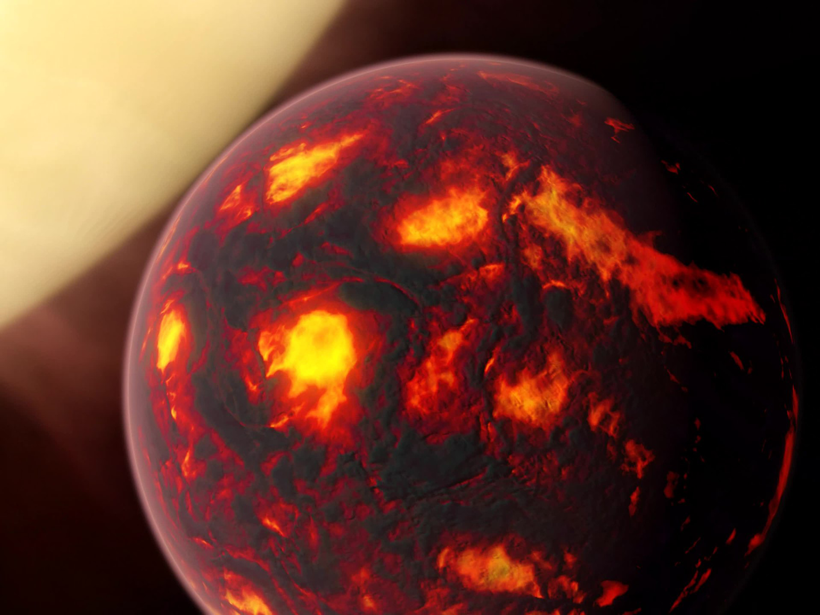
Newest among the old favorites soon to be studied by JWST is the TRAPPIST-1 system, which excited astronomers and the public alike when it was discovered to have seven possibly rocky Earth-sized planets.
A grand total of eight different programs will look at these planets’ atmospheric properties. “With this program,” said Olivia Lim, an astronomy doctoral student at Université de Montreal and PI for the program, “we are hoping to determine whether the planets have an atmosphere or not, at the very least, and if they do host atmospheres, we wish to detect the presence of molecules like [carbon dioxide, water, and ozone] in those atmospheres. This would be an important step in the search for traces of life outside the solar system.”
“JWST has a small chance of finding biosignatures on TRAPPIST-1 planets,” said Michael Zhang, “but a very good chance of telling us which molecules dominate the atmosphere and whether there are clouds.” Zhang is an astronomy graduate student at the California Institute of Technology in Pasadena.
Planetary Plot Twists
Some exoplanets just don’t fit inside the box as neatly as other exoplanets do, and astronomers are really hoping that JWST will help them understand why that is. Kataria leads the program to study one of these oddballs, HD 80606 b.
“HD 80606 b is an extreme hot Jupiter, and that’s saying something, given that hot Jupiters are pretty extreme to begin with!” Kataria said. “This Jupiter-sized exoplanet is on a highly eccentric, or elliptical, orbit and experiences a factor of greater than 800 variation in flux, or heating, throughout its 111-day orbit.”
“Most of the time it spends at relatively temperate distances,” Brandeker added, “but once every 111 days it swooshes very closely by the star in a few days so gets ‘flash heated.’”
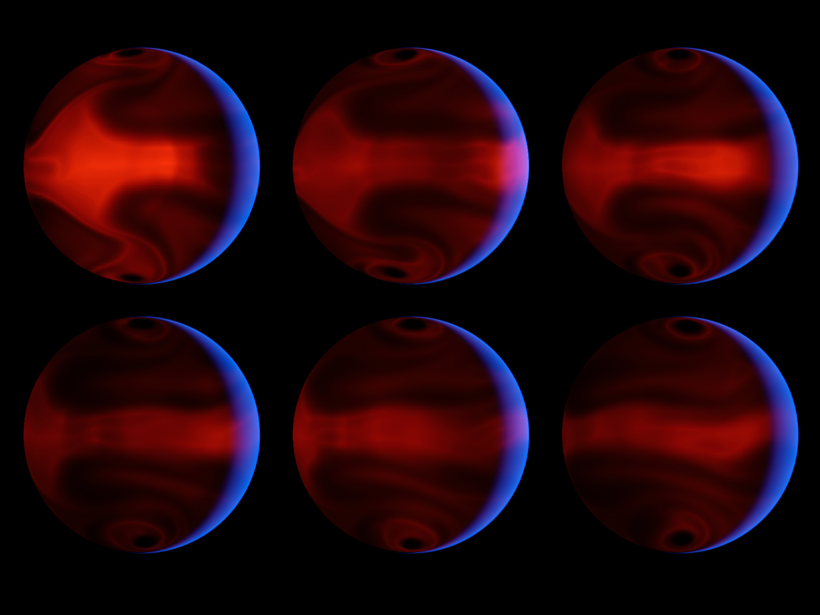
Studying HD 80606 b’s atmosphere as it heats and cools “will really help us examine the pure physics behind atmospheric energy transport, which is important for all worlds,” Wakeford said.
Kataria is also a coinvestigator on a program to make a 3D atmospheric map of a different oddity, WASP-121 b, a gas giant so hot that it bleeds heavy metals into space and orbits so close to its star that it’s shaped like a football. WASP-121 b is one example of a “super-puff” planet: These planets are roughly the size of Jupiter but far less massive, which makes their density closer to that of cotton candy. Pelletier will be looking at another super-puff, WASP-127 b. “Our hope is to gain a better understanding of the carbon budget on a planet vastly different from anything we have in our solar system,” he said.
What’s the most important thing to learn about super-puff planets? “Basically anything!” according to Gao, whose program will target super-puff Kepler-51 b. “All previous attempts at characterizing super-puff atmospheres have yielded featureless spectra and therefore very little information. If our observation is anything but a flat line, then we will have learned so much more than what we now know about these mysterious objects. It really is a fact-finding mission.”
M Dwarfs’ Breathtaking Aria
M dwarf stars are the smallest and most common stars in the universe, and astronomers have found that they host plenty of planets. Rocky habitable planets around these stars are easier to find using the two most prevalent methods—transits and radial velocity—but whether those planets can host atmospheres is still debated.
“I think the Cycle 1 observations will teach us a ton about whether rocky planets around M dwarfs can keep their atmospheres,” said Laura Kreidberg, director of research into the atmospheric physics of exoplanets at the Max Planck Institute for Astronomy in Heidelberg, Germany. “This is one of the most fundamental questions about where life is most likely to arise in the universe. There are tons of these small planets around small stars”— more than 1,500 are known so far—”but they experience more high-energy radiation over their lifetimes, so it’s not known whether they can keep their atmospheres. No atmosphere [is] bad news for life!”
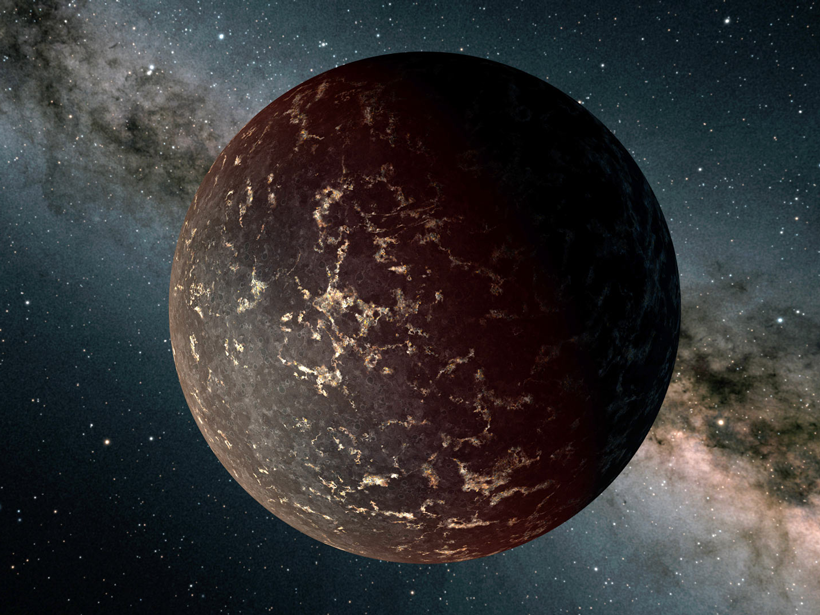
Both of Kreidberg’s observing programs will target rocky planets around M dwarfs. “One of the planets [LHS 3844 b] is already known to not have an atmosphere, so the goal of this program is to study the planet’s surface composition—what type of rock it’s made of—and search for any hints of volcanic activity, which could produce trace amounts of sulfur dioxide.”
Kreidberg is also looking at TRAPPIST-1 c, “which is very close to Venus in temperature. For that planet, I’m searching for absorption from carbon dioxide, to test whether the planet has a thick, Venus-like atmosphere or whether the atmosphere has been lost.”
“While we have made many models of atmospheric loss for small planets,” Gao said, “this will be our first real test of these theories. Will we find out that most characterizable rocky planets don’t actually have atmospheres and that our modeling efforts for their climates and habitability are futile? Or will we see a much more diverse set of atmospheric states? The results of these studies will be interesting and informative for future cycles regardless of what we find.”
Small-Planet Showstoppers
About half of JWST’s exoplanet-specific observing time will be dedicated to studying worlds smaller than Neptune. “This tells me without a doubt that the community is overwhelmingly interested in the little guys,” Gao said. These planets might be rocky (if they’re small enough) or could have a rock-ice core and a thick atmosphere.
“The large program on sub-Neptune and super-Earth atmospheres led by Natasha Batalha and Johanna Teske is especially exciting to me because it will provide us with a systematic survey of a class of planets that is not present in our solar system and was not readily observable with previous facilities,” Kempton said. “The potential for this program to unlock greater insight into the atmospheres of small planets is quite high.”

“These planets are so small that they’re beyond the reach of current technology, so anything JWST discovers will be a big improvement on what we know,” Zhang said. “For small planets like GJ 367 b, my target, and 55 Cancri e, we basically don’t know anything, so we’ll learn the first thing about them. Do they have atmospheres? If so, are they carbon dioxide, oxygen, or exotic metal atmospheres made of sodium and silicon oxide?”
One of Espinoza’s programs will focus on super-Earth K2-141 b, a planet only slightly larger and more massive than Earth but much, much hotter. “Depending on the properties of this exoplanet like the presence or not of an atmosphere, the flux change during its orbit around the star should give rise to very different signals, which will enable us to infer what this exoplanet’s exterior is made of,” said Espinoza.
If K2-141 b does have an atmosphere, it might not be the one it started with. Lisa Đặng aims to find out. Rocky planets as hot as that one “are thought to have lost any primordial atmosphere but, instead, could sustain a thin rock vapor atmosphere [that] outgasses from the mantle,” she said. Does the atmosphere stick around or rain back down? “With our observations we are hoping to detect molecular signatures of the atmospheric constituents and also obtain a map of the planet’s atmosphere and surface.”
Ballad of Planets and Disks
JWST should build upon discoveries made not only by space telescopes like Hubble and Spitzer but also by ground-based observatories like the Atacama Large Millimeter/submillimeter Array (ALMA). These observations will probe the birthplaces of planets: the disks of dust and gas around young stars. “Over the last decade, we’ve gotten gorgeous images from the ALMA interferometer in Chile and have seen loads of fine-scale structure, tracing pebbles in planet-forming disks,” said Ilse Cleeves, an astronomer at the University of Virginia in Charlottesville. “Some of the structures likely trace planets in formation, and so it’ll be very exciting to see what JWST uncovers, both in terms of patterns in the disk and perhaps even the drivers—protoplanets—themselves!”
Matthews added that “if JWST is able to successfully detect planets in these disks, it will be an important confirmation of our understanding of how planets interact with disks.” If no planets appear in the disks, astronomers will have to rethink how, and whether, planets shape disks.
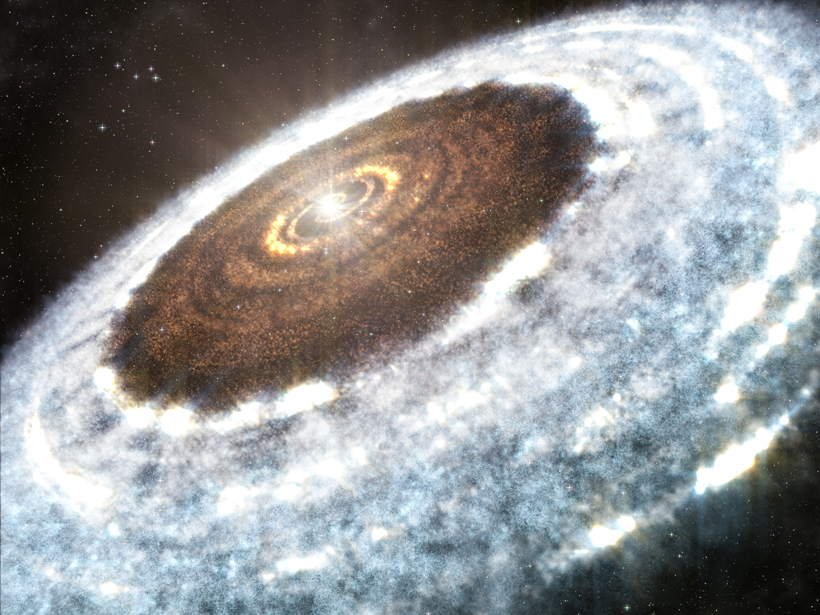
Cleeves will be studying planet-forming disks to understand how they give rise to habitable planets. “How common are habitable planets? Availability of water is a natural place to start, but we don’t have great observational constraints on how much water is present or the distribution of water in disks. We are looking forward to mapping out water ice in a nearby disk that happens to be posing in front of a host of background stars.” If a star’s light passes through a part of the disk that has ice, the ice will imprint a spectroscopic signal on the light. With so many background stars, Cleeves said, they’ll be able to say not just whether ice is present, but also where.
The makings of a world well suited for life go beyond the presence of water, however, and Melissa McClure‘s three observing programs will look for them. We’ll “trace how the elemental building blocks of life—like carbon, hydrogen, oxygen, nitrogen, and sulfur—evolve between molecular clouds, where they freeze out on dust grains as ices, and protoplanetary disks, where these ices are incorporated into forming planetesimals and, ultimately, planets,” she said. “I think that within a few years we will have an understanding of how much water terrestrial planets typically have and whether they inherited that water from their birth locations in their disks or if cometary delivery was necessary.” McClure is an assistant professor and a Veni Laureate at Leiden Observatory in the Netherlands.
A perhaps underrecognized component of JWST’s observing capabilities is the coronagraph that will allow direct imaging of exoplanet systems, meaning that the telescope will see light emitted by the planet itself. Coupled with JWST’s infrared capabilities, the telescope will be able to observe planets much older and colder than is currently possible. That’s Matthews’s aim. “Eps Indi Ab is similar in age to the solar system and is similarly far from its star as Jupiter is from the Sun. Because JWST is able to image much further into the infrared than Earth-based telescopes and because old planets are brighter at these very long wavelengths, our project provides a unique opportunity to study a truly Jupiter-like planet outside the solar system,” she said.
Sometimes planets survive their star’s demise, as is the case of WD 1856+534 b, a gas giant planet that orbits the slowly cooling corpse of a star, also known as a white dwarf. In this case, the planet’s survival presents a puzzle. “This planet orbits close enough to the white dwarf that it could not have originally orbited there before the star’s death. So how did it get there?” asked Andrew Vanderburg, whose program will target this system.
Bridge to Act II
Once the “shakedown cruise” is complete, Hannah Wakeford would like to see JWST used to study more worlds the size of Jupiter, Saturn, and Neptune. “There is so much we can learn that we can’t even get from our own solar system giant planets,” she said, “so it is, in my opinion, a low-risk, high-reward scenario.”
On Vanderburg’s wish list: “Disintegrating planets. These will be great probes of the interior compositions of planets, so I hope we will get observations of them in the future.”
Cleeves called the first cycle “a great place to start. I have a feeling, though, that the most interesting next projects are those that we haven’t anticipated yet, so I’m really looking forward to the first couple of years with JWST, grappling with the data and finding those unexpected puzzles.”
Espinoza agreed. “I’m almost convinced features will show up in the data that we will perhaps not be able to explain right away,” he said. “As such, the very first exoplanetary observations to be made by JWST are going to be a big jump into the known unknown…. As the title of an album of one of my favorite rock bands would say, ‘Expect the unexpected.’”
Author Information
Kimberly M. S. Cartier (@AstroKimCartier), Staff Writer






